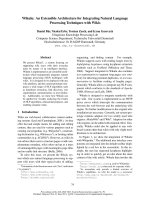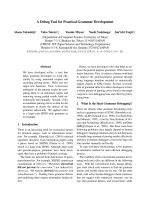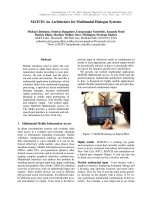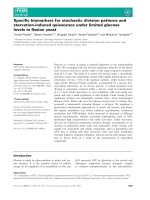Báo cáo khoa học: "Aflexible distributed architecture for NLP system development and use" pdf
Bạn đang xem bản rút gọn của tài liệu. Xem và tải ngay bản đầy đủ của tài liệu tại đây (334.11 KB, 4 trang )
A flexible distributed architecture for NLP system
development and use
Freddy Y. Y. Choi
Artificial Intelligence Group
University of Manchester
Manchester, U.K.
Abstract
We describe a distributed, modular architecture
for platform independent natural language sys-
tems. It features automatic interface genera-
tion and self-organization. Adaptive (and non-
adaptive) voting mechanisms are used for inte-
grating discrete modules. The architecture is
suitable for rapid prototyping and product de-
livery.
1 Introduction
This article describes TEA 1, a flexible architec-
ture for developing and delivering platform in-
dependent text engineering (TE) systems. TEA
provides a generalized framework for organizing
and applying reusable TE components (e.g. to-
kenizer, stemmer). Thus, developers are able
to focus on problem solving rather than imple-
mentation. For product delivery, the end user
receives an exact copy of the developer's edition.
The visibility of configurable options (different
levels of detail) is adjustable along a simple gra-
dient via the automatically generated user inter-
face (Edwards, Forthcoming).
Our target application is telegraphic text
compression (Choi (1999b); of Roelofs (Forth-
coming); Grefenstette (1998)). We aim to im-
prove the efficiency of screen readers for the
visually disabled by removing uninformative
words (e.g. determiners) in text documents.
This produces a stream of topic cues for rapid
skimming. The information value of each word
is to be estimated based on an unusually wide
range of linguistic information.
TEA was designed to be a development en-
vironment for this work. However, the target
application has led us to produce an interesting
tTEA is an acronym for Text Engineering Architec-
ture.
architecture and techniques that are more gen-
erally applicable, and it is these which we will
focus on in this paper.
2 Architecture
I
System
input
and output
I I L
I I
Plug*ins Shared knowledge System
control
s~ructure
Figure 1: An overview of the TEA system
framework.
The central component of TEA is a frame-
based data model (F) (see Fig.2). In this model,
a document is a list of frames (Rich and Knight,
1991) for recording the properties about each
token in the text (example in Fig.2). A typical
TE system converts a document into F with an
input plug-in. The information required at the
output determines the set of process plug-ins to
activate. These use the information in F to add
annotations to F. Their dependencies are auto-
matically resolved by TEA. System behavior is
controlled by adjusting the configurable param-
eters.
Frame 1: (:token An :pos art :begin_s 1)
Frame 2: (:token example :pos n)
Frame 3: (:token sentence :pos n)
Frame 4: (:token . :pos punc :end_s 1)
Figure 2: "An example sentence." in a frame-
based data model
615
This type of architecture has been imple-
mented, classically, as a 'blackboard' system
such as Hearsay-II (Erman, 1980), where inter-
module communication takes place through a
shared knowledge structure; or as a 'message-
passing' system where the modules communi-
cate directly. Our architecture is similar to
blackboard systems. However, the purpose of
F (the shared knowledge structure in TEA) is
to provide a single extendable data structure for
annotating text. It also defines a standard in-
terface for inter-module communication, thus,
improves system integration and ease of soft-
ware reuse.
2.1 Voting mechanism
A feature that distinguishes TEA from similar
systems is its use of voting mechanisms for sys-
tem integration. Our approach has two distinct
but uniformly treated applications. First, for
any type of language analysis, different tech-
niques ti will return successful results
P(r)
on
different subsets of the problem space. Thus
combining the outputs
P(rlti)
from several ti
should give a result more accurate than any one
in isolation. This has been demonstrated in sev-
eral systems (e.g. Choi (1999a); van Halteren
et al. (1998); Brill and Wu (1998); Veronis and
Ide (1991)). Our architecture currently offers
two types of voting mechanisms: weighted av-
erage (Eq.1) and weighted maximum (Eq.2). A
Bayesian classifier (Weiss and Kulikowski, 1991)
based weight estimation algorithm (Eq.3) is in-
cluded for constructing adaptive voting mecha-
nisms.
P(r) = w P(rlti)
i=1
(1)
P(r)
= max{WlP(rltx), ,w,,P(rlt,)} (2)
=
P(rlt,)) (3)
Second, different types of analysis a/ will pro-
vide different information about a problem,
hence, a solution is improved by combining sev-
eral ai. For telegraphic text compression, we es-
timate
E(w),
the information value of a word,
based on a wide range of different information
sources (Fig.2.1 shows a subset of our working
system). The output of each
ai are
combined by
a voting mechanism to form a single measure.
Vo~ng mechanism 0
Pmcoss
0
I " "I
l I I !
Technique Ane~ysis
com~na~on
¢om~n~on
Figure 3: An example configuration of TEA for
telegraphic text compression.
Thus, for example, if our system encoun-
ters the phrase 'President Clinton', both lexical
lookup and automatic tagging will agree that
'President' is a noun. Nouns are generally infor-
mative, so should be retained in the compressed
output text. However, grammar-based syntac-
tic analysis gives a lower weighting to the first
noun of a noun-noun construction, and bigram
analysis tells us that 'President Clinton' is a
common word pair. These two modules overrule
the simple POS value, and 'President Clinton'
is reduced to 'Clinton'.
3 Related work
Current trends in the development of reusable
TE tools are best represented by the Edinburgh
tools (LTGT) 2 (LTG, 1999) and GATE 3 (Cun-
ningham et al., 1995). Like TEA, both LTGT
and GATE are frameworks for TE.
LTGT adopts the pipeline architecture for
module integration. For processing, a text doc-
ument is converted into SGML format. Pro-
cessing modules are then applied to the SGML
file sequentially. Annotations are accumulated
as mark-up tags in the text. The architecture is
simple to understand, robust and future proof.
The SGML/XML standard is well developed
and supported by the community. This im-
proves the reusability of the tools. However,
2LTGT is an acronym for the Edinburgh Language
Technology Group
Tools
aGATE is an acronym for General Architecture for
Text Engineering.
616
tile architecture encourages tool development
rather than reuse of existing TE components.
GATE is based on an object-oriented data
model (similar to the TIPSTER architecture
(Grishman, 1997)). Modules communicate by
reading and writing information to and from a
central database. Unlike LTGT, both GATE
and TEA are designed to encourage software
reuse. Existing TE tools are easily incorporated
with Tcl wrapper scripts and Java interfaces, re-
spectively.
Features that distinguish LTCT, GATE and
TEA are the configuration methods, portabil-
ity and motivation. Users of LTGT write shell
scripts to define a system (as a chain of LTGT
components). With GATE, a system is con-
structed manually by wiring TE components to-
gether using the graphical interface. TEA as-
sumes the user knows nothing but the available
input and required output. The appropriate set
of plug-ins are automatically activated. Module
selection can be manually configured by adjust-
ing the parameters of the voting mechanisms.
This ensures a TE system is accessible to com-
plete novices ~,,-I yet has sufficient control for
developers.
LTGT and GATE are both open-source C ap-
plications. They can be recompiled for many
platforms. TEA is a Java application. It can
run directly (without compilation) on any Java
supported systems. However, applications con-
structed with the current release of GATE and
TEA are less portable than those produced with
LTGT. GATE and TEA encourage reuse of ex-
isting components, not all of which are platform
independent 4. We believe this is a worth while
trade off since it allows developers to construct
prototypes with components that are only avail-
able as separate applications. Native tools can
be developed incrementally.
4 An example
Our application is telegraphic text compression.
The examples were generated with a subset of
our working system using a section of the book
HAL's legacy
(Stork, 1997) as test data. First,
we use different compression techniques to gen-
erate the examples in Fig.4. This was done by
simply adjusting a parameter of an output plug-
4This
is not
a problem for LTGT since the architec-
ture does not encourage component reuse.
in. It is clear that the output is inadequate for
rapid text skimming. To improve the system,
the three measures were combine with an un-
weighted voting mechanism. Fig.4 presents two
levels of compression using the new measure.
1. With science fiction films the more science
you understand the less you admire the film or
respect its makers
2. fiction films understand less admire respect
makers
3. fiction understand less admire respect makers
4. science fiction films science film makers
Figure 4: Three measures of information value:
(1) Original sentence, (2) Token frequency, (3)
Stem frequency and (4) POS.
1. science fiction films understand less admire
film respect makers
2. fiction makers
Figure 5: Improving telegraphic text compres-
sion by analysis combination.
5 Conclusions and future directions
We have described an interesting architecture
(TEA) for developing platform independent
text engineering applications. Product delivery,
configuration and development are made sim-
ple by the self-organizing architecture and vari-
able interface. The use of voting mechanisms
for integrating discrete modules is original. Its
motivation is well supported.
The current implementation of TEA is geared
towards token analysis. We plan to extend
the data model to cater for structural annota-
tions. The tool set for TEA is constantly be-
ing extended, recent additions include a proto-
type symbolic classifier, shallow parser (Choi,
Forthcoming), sentence segmentation algorithm
(Reynar and Ratnaparkhi, 1997) and a POS
tagger (Ratnaparkhi, 1996). Other adaptive
voting mechanisms are to be investigated. Fu-
ture release of TEA will support concurrent ex-
ecution (distributed processing) over a network.
Finally, we plan to investigate means of im-
proving system integration and module orga-
nization, e.g. annotation, module and tag set
compatibility.
617
References
E. Brill and J. Wu. 1998. Classifier combina-
tion for improved lexical disambiguation. In
Proceedings of COLING-A CL '98,
pages 191-
195, Montreal, Canada, August.
F. Choi. 1999a. An adaptive voting mechanism
for improving the reliability of natural lan-
guage processing systems. Paper submitted
to EACL'99, January.
F. Choi. 1999b. Speed reading for the
visually disabled. Paper submitted to
SIGART/AAAI'99 Doctoral Consortium,
February.
F. Choi. Forthcoming. A probabilistic ap-
proach to learning shallow linguistic patterns.
In
ProCeedings of ECAI'99 (Student Session),
Greece.
H. Cunningham, R.G. Gaizauskas, and
Y. Wilks. 1995. A general architecture for
text engineering (gate) - a new approach
to language engineering research and de-
velopment. Technical Report CD-95-21,
Department of Computer Science, University
of Sheffield.
lg/9601009.
M. Edwards. Forthcoming. An approach to
automatic interface generation. Final year
project report, Department of Computer Sci-
ence, University of Manchester, Manchester,
England.
L. Erman. 1980. The hearsay-ii speech under-
standing system: Integrating knowledge to
resolve uncertainty. In
A CM Computer Sur-
veys,
volume 12.
G. Grefenstette. 1998. Producing intelligent
telegraphic text reduction to provide an audio
scanning service for the blind. In
AAAI'98
Workshop on Intelligent Text Summariza-
tion,
San Francisco, March.
R. Grishman. 1997. Tipster architecture de-
sign document version 2.3. Technical report,
DARPA. .
LTG. 1999. Edinburgh univer-
sity, hcrc, ltg software. WWW.
H. Rollfs of Roelofs. Forthcoming. Telegraph-
ese: Converting text into telegram style.
Master's thesis, Department of Computer Sci-
ence, University of Manchester, Manchester,
England.
G. M. P. O'Hare and N. R. Jennings, edi-
tots. 1996.
Foundations of Distributed Ar-
tificial Intelligence.
Sixth generation com-
puter series. Wiley Interscience Publishers,
New York. ISBN 0-471-00675.
A. Ratnaparkhi. 1996. A maximum entropy
model for part-of-speech tagging. In
Proceed-
ings of the empirical methods in NLP confer-
ence,
University of Pennsylvania.
J. Reynar and A. Ratnaparkhi. 1997. A max-
imum entropy approach to identifying sen-
tence boundaries. In
Proceedings of the fifth
conference on Applied NLP,
Washington D.C.
E. Rich and K. Knight. 1991.
Artificial Intel-
ligence.
McGraw-Hill, Inc., second edition.
ISBN 0-07-100894-2.
D. Stork, editor. 1997.
Hal's Legacy: 2001's
Computer in Dream and Reality.
MIT Press.
http: / / mitpress.mit.edu[ e-books /Hal /.
H. van Halteren, J. Zavrel, and W. Daelemans.
1998. Improving data driven wordclass tag-
ging by system combination. In
Proceedings
of COLING-A CL'g8,
volume 1.
J. Veronis and N. Ide. 1991. An accessment of
semantic information automatically extracted
from machine readable dictionaries. In
Pro-
ceedings of EA CL'91,
pages 227-232, Berlin.
S. Weiss and C. Kulikowski. 1991.
Computer
Systems That Learn.
Morgan Kaufmann.
618









